My subjective selection of 7 items not to be missed at the Musée d'Aquitaine old times section
I would like to share with you my selection of works of art that should not be missed at the Musée d'Aquitaine.
Bordeaux has one of the largest provincial history museums in France. Throughout the collections, you will discover Prehistory, Antiquity, the Middle Ages, the 18th century (the golden age of the city of Bordeaux) and all the periods that made up the region's rich history.
For the more than acceptable amount of €5, you can join the 150,000 visitors who visit the Aquitaine Museum every year. It presents the history of Bordeaux and Aquitaine region on 2 floors, from prehistory to the present day, through a permanent collection of very varied objects.
When you follow a guide, the advantage is that you will be explained what you see... The tour guide will try to draw your attention to the essential parts. The disadvantage is that you will always see things through my eyes and it is often very subjective.... But if you trust me, I'll show you some interesting things, through a very subjective selection of meaningful items...... I chose here to focus on my 7 favorite items from the permanent collection at the Musée d'Aquitaine that I unroll in the chronological order of the rooms of the groundfloor, from Antiquity to Renaissance.
I will not dwell on the first rooms that concern prehistory, then the Bronze Age and the Iron Age, although I highly recommend you spend some time in the small room dedicated to the cave of Pair-non-Pair or in front of what is called the Tayac treasure and more particularly this splendid golden torc in the last display glass case.
On the other hand, as soon as you enter the Gallo-Roman space, stay close to the facsimile reconstruction of the Bordeaux rampart. Its discovery during the major phases of work in the 19th century enabled us to make great progress in terms of archaeology since the base of the rampart is made of stones that were taken from ancient monuments that were no longer used after its construction and the withdrawal phase of the city (about IIIrd century). Today, they are stone puzzles for historians who find interesting elements but out of context. We don't know where they come from or when they really date back. They are called about reused stones, reclaimed from Antiquity.
The antic reused stones of the Roman rampart of Bordeaux
 One of them is fascinating. It represents a scene of dendrophors. Yes, I know.... "Beg your pardon????"
One of them is fascinating. It represents a scene of dendrophors. Yes, I know.... "Beg your pardon????"
This scene of dendrophors refers to the cult of Cybele, an ancient religion. They are tree carriers.
Although it is not my intention, I sometimes offend certain well-meaning Christians by insisting on the ease with which the monotheistic religions that still exist today have been able to appropriate the ancient myths that had lasted for centuries.
In this myth, Attis, Cybele's lover and adopted son, refuses to accept her. Revenge: she drives him mad to the point of emasculating. His blood fertilizes the earth from which an evergreen pine tree, symbol of eternity, will spring. Attis will die of his wounds but Cybele finally calmed down and brought him back to life.
As if by chance, the rites took place around March 20th (and are not so far from our Easter holidays). During these rites, the dendrophors wore a pine tree rolled in pieces of cloth similar to a shroud to the temple of Cybele, the pine representing Attis' body after his death.
This ceremony was followed by rites, each more bloody than the next... of laceration of flesh and emasculation, which we will not detail here. From then on, after a night of union with the goddess, like the resurrected Attis, joy and spring return.
The Jupiter from the roman sanctuary in Mezin
This magnificent statue of Jupiter was found in a sanctuary in Mezin in Lot-et-Garonne in 1972 by a farmer. This limestone statue of the Roman god Jupiter is the centrepiece of an exceptional archaeological ensemble found in situ.
This statue is already exceptional in size: it is more than 1.80 m tall but then because it is one of the very few statues of Jupiter that has been found in its sanctuary environment.
It was acquired in 2001 by the Musée d'Aquitaine.
Dated back to the 1st century AD, big of stature, this Jupiter is also impressive by its attributes: the lance in the right hand and the lightning in the left hand. The pose, hair and muscles are characteristic of the artist's Greek influence.
The three-headed god known as Cerumnos (Roman display cases)
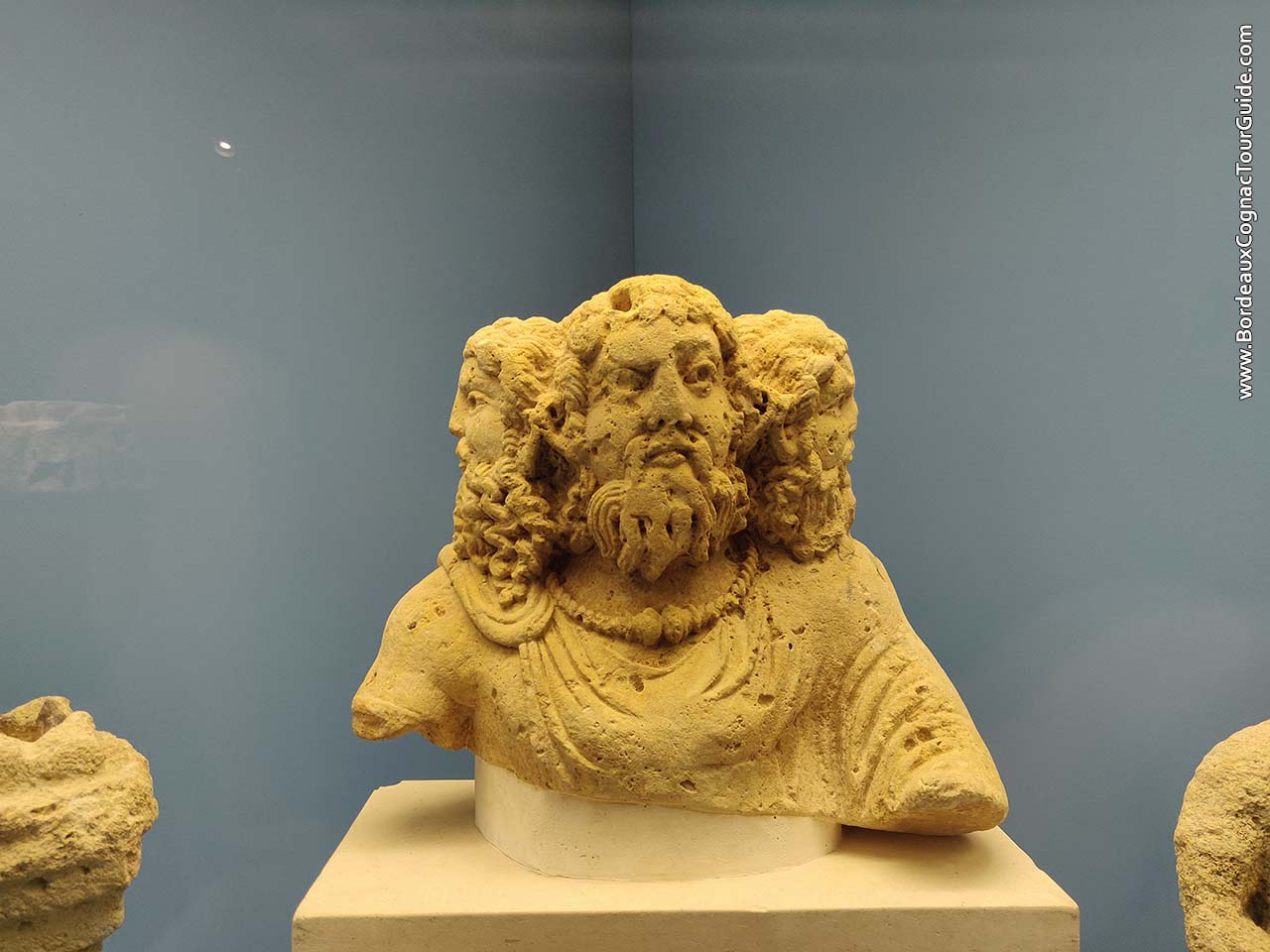 Cernunnos is a Gallic god. No text relating to him has been kept. We can only rely on interpretations of his representations to understand his role in the Gallic and then Gallo-Roman religion.
Cernunnos is a Gallic god. No text relating to him has been kept. We can only rely on interpretations of his representations to understand his role in the Gallic and then Gallo-Roman religion.
A major figure in the Celtic pantheon, Cernunnos is said to embody the biological cycle of nature, a simultaneous symbol of life and death, germination and decline... A little like the deer, the animal that symbolizes him: it loses its antlers in winter to recover them in spring.
In front of this small three-headed statue (tri-cephalus), please pay attention the holes at the top of the head where horns (antlers) probably came to be embedded.
We can suppose that the three-headed god, of Celtic origin, symbolically represents 3 different states of being, such as sleep, dream and awareness, or the past, present and future... This is still very mysterious and subject to many hypotheses....
The representation of Cernunnos, a half-human, half-animal god, ceased around the second century of our era. The main Gallic cultural pillars were absorbed in those of the Romans.
This is indeed the representation of a three-headed god of the Gallic type, but dating back to the Roman period. This sculpture is a testament to the assimilation of the Gallic rites in Roman times.
Some later representations show us traces of survival. But this horned god was probably assimilated to the Devil by Catholics, in order to keep the people away from these pagan cults.
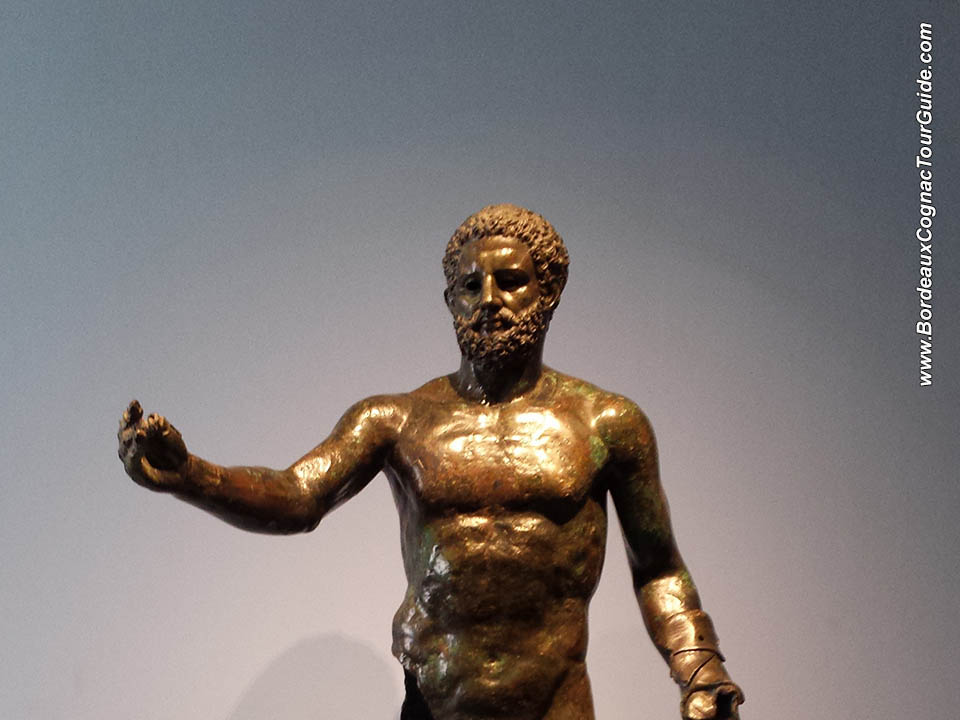 The Hercules bronze Statue called "Hercules from Bordeaux"
The Hercules bronze Statue called "Hercules from Bordeaux"
The guy is too easy to recognize.... Look at his arm and you cannot miss the rolled lion skin! It is the skin of the Lion of Nemea, killed during the first of his 12 works.
The Hercules of Bordeaux was discovered in 1832 broken into about twenty pieces, in a sewer of a house at the entrance of the impasse Saint-Pierre (very close to the church and the layout of the Gallo-Roman enclosure). A masterpiece of the Musée d'Aquitaine, it remains one of the very few large Roman bronzes preserved in France.
1.32 m (as it stands) for 90 kg of bronze, it's yet another good-looking guy of the collection of the Musée d'Aquitaine!
He is represented here in heroic nudity, leaning on his right leg, the other leg a little backwards, with an exaggerated wiggle, following the Greek style.
Its delicacy and precision let us imagine the opulence of the port of Bordeaux..... To be able to show and order a statue of such a high quality when Bordeaux is not even the capital of Aquitania yet (and yes... it is still Saintes at that time!). But especially look at the inlays of other metals to highlight lips, eyebrows or nipples.... What precision! One can only imagine the stones that must have been used for the eyes but disappeared today.
The wooden statue of Saint James The Greater (Santiago)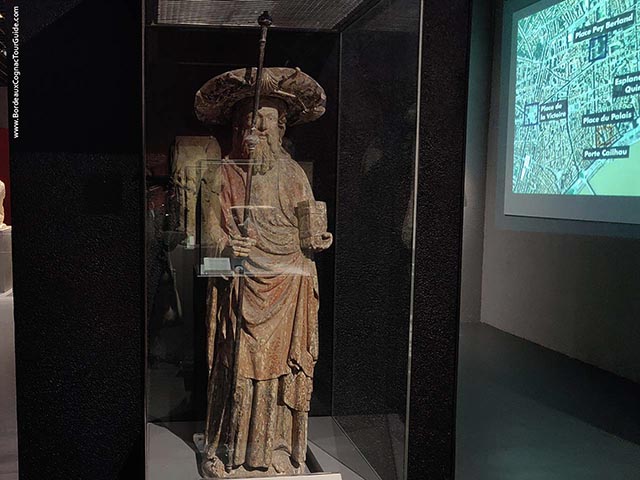
We'll have to be careful not to miss it..... It is behind a pilar that closes the medieval coat of arms room, on your left and in a large glass display box.
The pilgrimage to Compostela was one of the major commitments of Christians in the Middle Ages and the Renaissance. And Bordeaux is located on via Turonensis, which descends from Tours to Spain. Bordeaux was honoured by UNESCO in 1998, particularly for the Cathedral Saint-André, the Basilicas Saint-Seurin and Saint-Michel, which were important stops on the way to Santiago.
This superb statue of Santiago is made of polychrome wood and dates back to the 15th century.
 The Rose of the Carmelite monastery
The Rose of the Carmelite monastery
At the end of the tour of the medieval rooms, you will see something unique! It is a gothic rose coming from the Church of the Great Carmelites (13th century). It's flamboyant Gothic Art. It was discovered during some archaeological excavations in 1986 near Cours Victor Hugo (nearby the museum). In several pieces when it was discovered, it was reconstructed and is presented here vertically on a custom-built scaffold.
This rose is the largest rose presented vertically in a museum. Imagine the little stuff.... 5 tons for 5 m in diameter!
It therefore comes from the former monastery of the Grand Carmelites. Saint Simon Stock, the general Prior of the Order, died there in 1265. Since the Revolution, his relics have been displayed in the Chapel of Our Lady of Mount Carmel in Saint Andrew's Cathedral.
Simon Stock was a 13th century English Carmelite. He was one of the first Generals of the Carmelite Order and remained one of the most famous ones. His fame comes from visions of the Virgin Mary giving him the Scapular.
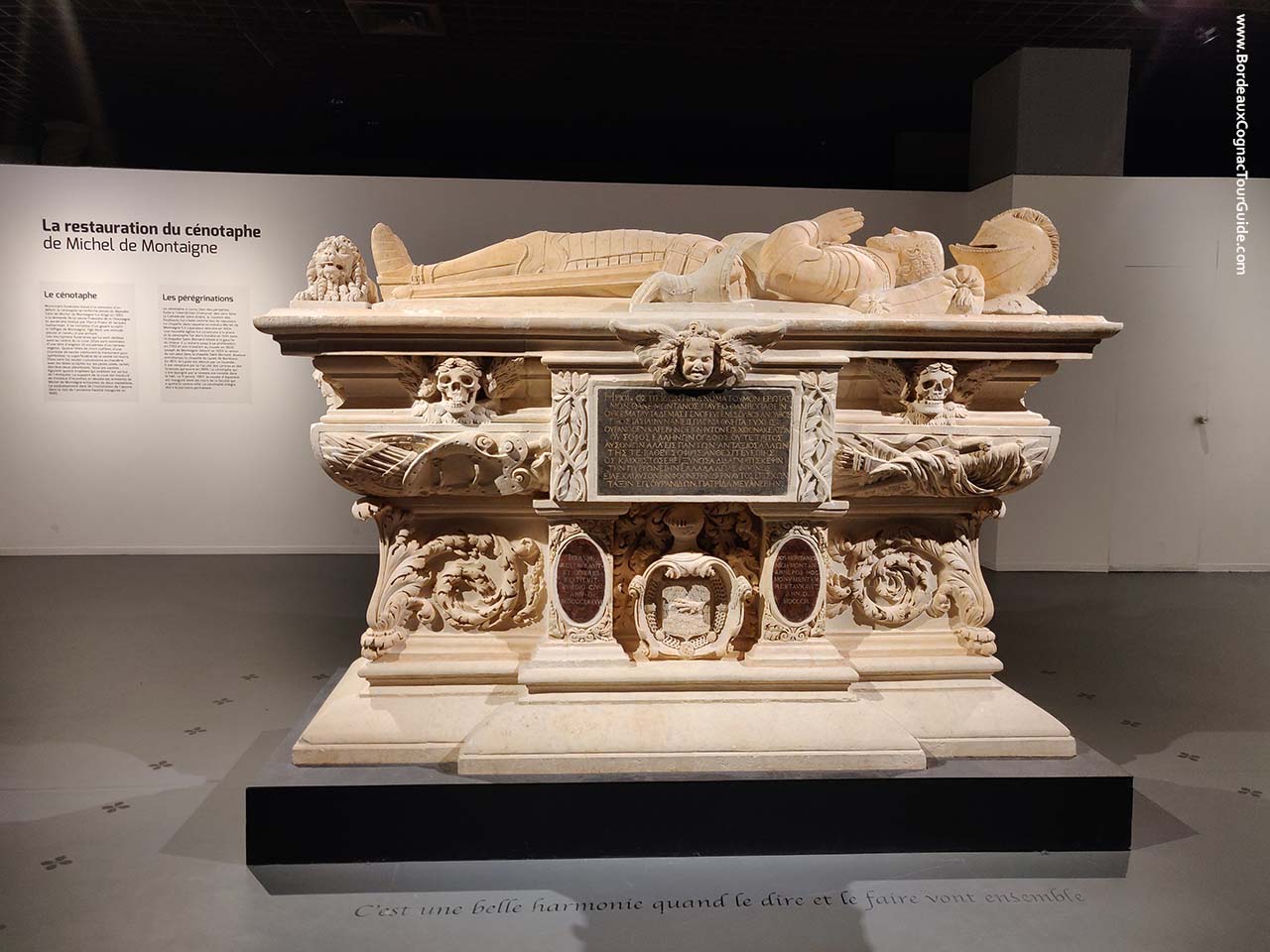 Michel de Montaigne's cenotaph (Funeral monument)
Michel de Montaigne's cenotaph (Funeral monument)
Several generations of students followed one another when the place was used to be the former Bordeaux Faculty of Science and Letters. They were welcomed by the funeral of Montaigne which occupied the central square of the entrance hall. This former faculty now houses the Musée d'Aquitaine.
In fact, it is not strictly speaking a tomb, it is a cenotaph : that is, a monument erected to the glory of the dead one but which does not really contain any body. It was sculpted in 1593, one year after his death at the request of Françoise de la Chassaigne, his wife.
Its location here within the former faculty, then at the Musée d'Aquitaine since the 1980's, is more than legitimate. Indeed, Montaigne had been buried in the former monastery of Feuillants built here on the same site at the end of the Middle Ages!
At is feet, in accordance with medieval iconography, the lion symbolizes the courage of the deceased but also Montaigne's noble social origin. Its representation in armor has the same purpose.
It was restored for nearly 70 days between September 2017 and January 2018. It has been visible again since March 2018, thanks to the patronage campaign that made the restoration possible.
If you didn't know it, in addition to his literary legacy, Montaigne was mayor of Bordeaux in the 16th century!
Bordeaux, Bordeaux shore excursions, French history, Licensed Bordeaux tour guide, Bordeaux Private Tours, Bordeaux tourist guide, Bordeaux guided tours
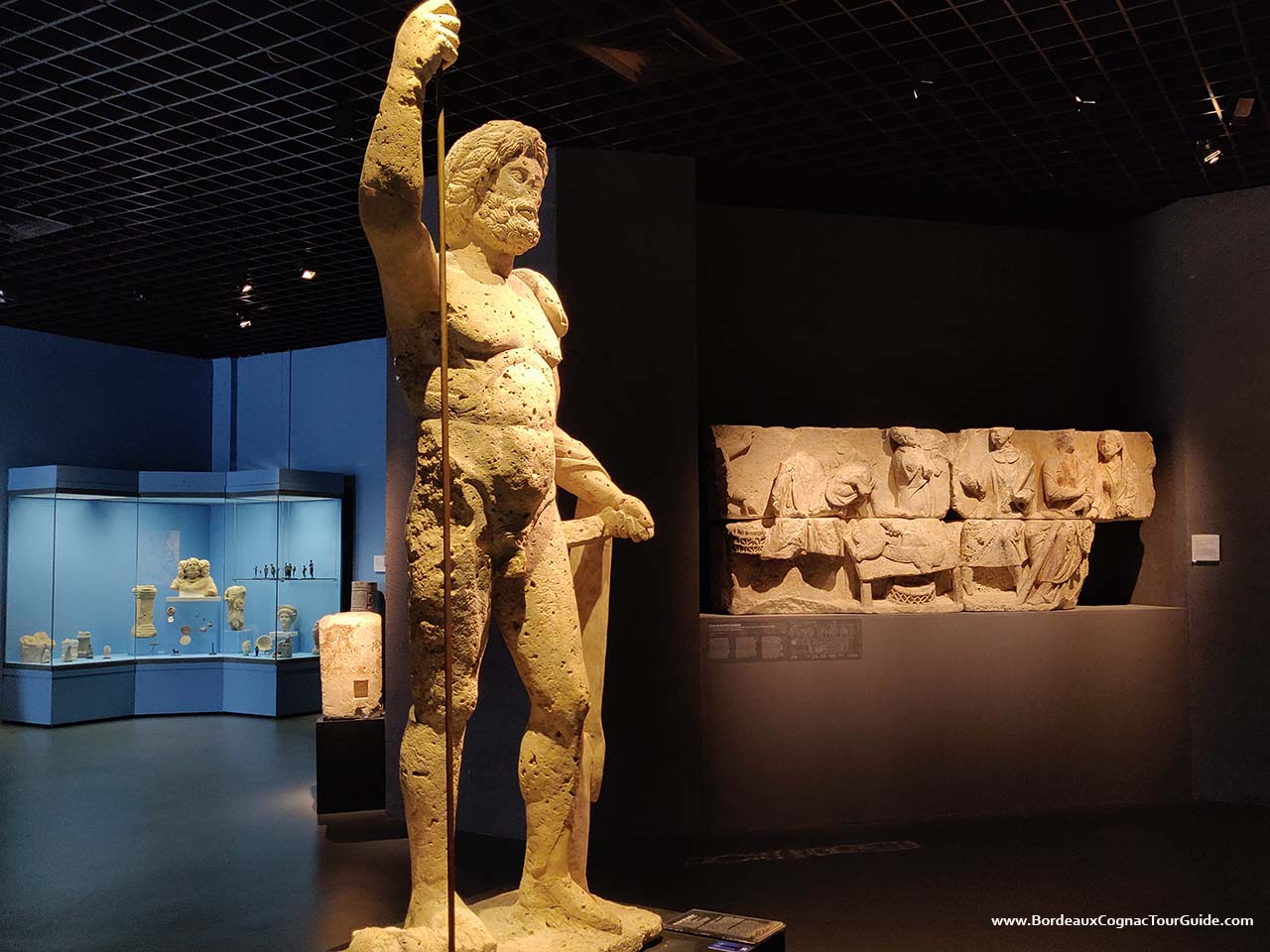
Terms & Conditions
Report